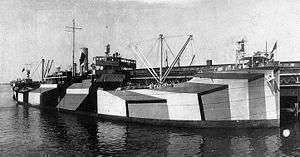USS West Compo (ID-3912)
 West Compo had design and measurements similar to West Shore, a sister ship from the same shipyard seen here c. 1918. | |
| History | |
|---|---|
| Name: | West Compo |
| Owner: | USSB |
| Builder: | |
| Yard number: | 20[1] |
| Completed: | January 1919[1] |
| Identification: | US official number: 217936[2] |
| Fate: | abandoned 1933,[3] scrapped 1936[1][2] |
| General characteristics | |
| Type: | Design 1013 ship |
| Tonnage: | 5,700 GRT[4] |
| Displacement: | 12,185 t[3] |
| Length: | |
| Beam: | 54 ft 0 in (16.46 m)[3] |
| Draft: | 24 ft 6 in (7.47 m) (mean)[3] |
| Depth of hold: | 29 ft 9 in (9.07 m) |
| Propulsion: | 1 × steam turbine[2] |
| Speed: | 11.5 knots (21.3 km/h)[2] |
| Capacity: | 8,635 DWT[4] |
USS West Compo (ID-3912) was a cargo ship for the United States Navy in 1919. The ship was built in 1919 as SS West Compo, a steam-powered cargo ship for the United States Shipping Board (USSB) as part of the West boats, a series of steel-hulled cargo ships built on the West Coast of the United States for the World War I war effort. She was the 20th ship built by Northwest Steel in Portland, Oregon. She was commissioned into the Naval Overseas Transportation Service (NOTS) of the United States Navy in January 1919. After one overseas trips for the Navy, she was decommissioned in May 1919 and returned to the USSB.
It is not known if West Compo had a civilian career after her Navy career ended. Sources conflict as to the ship's ultimate fate, but she was probably broken up in 1936 at Baltimore, Maryland.
Design and construction
The West ships were cargo ships of similar size and design built by several shipyards on the West Coast of the United States for the United States Shipping Board (USSB) for emergency use during World War I. All were given names that began with the word West, like West Compo,[5] one of some 40 West ships built by Northwest Steel of Portland, Oregon.[1] West Compo (Northwest Steel yard number 20, USSB hull number 1080) was completed in January 1919.[1]
West Compo was 5,700 gross register tons (GRT),[2] and was 409 feet 5 inches (124.79 m) long (between perpendiculars) and 54 feet (16.5 m) abeam.[2][3] West Compo had a steel hull and a mean draft of 24 feet 6 inches (7.47 m).[3] She displaced 12,185 t,[3] and had a deadweight tonnage of 8,635 DWT.[4] The ship had a single steam turbine that drove her single screw propeller, and moved the ship at a 11.5-knot (21.3 km/h) pace.[2]
Military career
USS West Compo (ID-3912) was commissioned into the Naval Overseas Transportation Service (NOTS) on 3 February 1919 with Lieutenant Commander A. A. Modeer, USNRF, in command. The ship sailed on 12 February with on a load of wheat flour and transited the Panama Canal on 1 and 2 March.[3][Note 1] After she arrived in Norfolk, Virginia, on 11 March, she replenished her fuel and stores and got underway for the Mediterranean on 14 March. West Compo arrived at Trieste on 9 April and unloaded her cargo. After taking on sand ballast, she departed on 19 April, sailing to Philadelphia via Gibraltar. She arrived at Philadelphia on 15 May, was decommissioned one week later, and returned to the USSB.[3]
Civilian career
After the Navy decommissioned West Compo it is not known if she had a civilian career for the USSB.The ship does not appear in contemporary newspaper reports and there is no evidence that she was ever sold. The Dictionary of American Naval Fighting Ships reports that the ship was abandoned by the USSB in 1933.[3] Jordan lists her as still under USSB ownership in 1939,[4] but Haworth reports that the ship was broken up in Baltimore in April 1936.[2] Colton also reports the ship as being scrapped in 1936.[1]
Notes
- ↑ Many West ships, to avoid sailing empty to the East Coast, loaded grain products intended for the United Kingdom, France, and Italy, sailed to Europe without unloading or transferring their cargo, which avoided extra handling of the cargo. The United States Shipping Board, by prior arrangement, received an equivalent amount of cargo space in foreign ships for other American cargos. See: Crowell and Wilson, pp. 358–59.
References
- 1 2 3 4 5 6 Colton, Tim. "Northwest Steel, Portland OR". Shipbuildinghistory.com. The Colton Company. Retrieved 23 September 2008.
- 1 2 3 4 5 6 7 8 9 "West Compo". Miramar Ship Index. R.B.Haworth. Retrieved 23 September 2008.
- 1 2 3 4 5 6 7 8 9 10 11 Naval Historical Center. "West Compo". DANFS.
- 1 2 3 4 Jordan, p. 432.
- ↑ Crowell and Wilson, pp. 358–59.
Bibliography
- Crowell, Benedict; Robert Forrest Wilson (1921). The Road to France: The Transportation of Troops and Military Supplies, 1917–1918. How America Went to War: An Account From Official Sources of the Nation's War Activities, 1917–1920. New Haven: Yale University Press. OCLC 18696066.
- Jordan, Roger W. (2006) [1999]. The World's Merchant Fleets, 1939: The Particulars And Wartime Fates of 6,000 Ships. Annapolis, Maryland: Naval Institute Press. ISBN 978-1-59114-959-0. OCLC 150361480.
- Naval Historical Center. "West Compo". Dictionary of American Naval Fighting Ships. Navy Department, Naval History & Heritage Command. Retrieved 23 September 2008.
External links
- Photo gallery of West Compo at NavSource Naval History